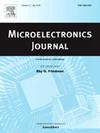A high power supply rejection LDO with ripple neutralization technique for Sigma-Delta D/A converter
IF 1.9
3区 工程技术
Q3 ENGINEERING, ELECTRICAL & ELECTRONIC
引用次数: 0
Abstract
A ripple neutralization technology is proposed to enhance the power supply rejection ratio (PSRR) of the low dropout regulator (LDO). By designing a bandgap reference in which the output ripple is in complementary phase with the power supply ripple, the output ripple of the bandgap reference passes through the LDO main loop and neutralizes the component of the power supply ripple transmitted to the LDO output. This reduces the impact of power supply ripple on the LDO output and enhances the PSRR of the LDO. An LDO with ripple neutralization technology is designed in the 180 nm Bipolar-CMOS-DMOS (BCD) process. In the frequency range of 0–100 kHz, the PSRR of the bandgap reference and the main loop of the LDO are −37.43 dB and −30.81 dB, respectively. With the proposed ripple neutralization technique, the PSRR of the LDO is improved from −30.81 dB to −73.17 dB without adding additional circuits, making it very suitable for application in high-precision data converters.
一种用于Sigma-Delta D/A转换器的高电源抑制LDO及纹波中和技术
为了提高低差稳压器的电源抑制比(PSRR),提出了一种波纹中和技术。通过设计一个输出纹波与电源纹波互为互补相位的带隙基准,带隙基准的输出纹波通过LDO主环路,中和了传输到LDO输出的电源纹波分量。这样可以减少电源纹波对LDO输出的影响,提高LDO的PSRR。在180nm双极cmos - dmos (BCD)工艺中设计了一种带纹波中和技术的LDO。在0 ~ 100 kHz频率范围内,带隙基准和LDO主回路的PSRR分别为- 37.43 dB和- 30.81 dB。采用所提出的纹波中和技术,在不增加额外电路的情况下,LDO的PSRR从−30.81 dB提高到−73.17 dB,非常适合应用于高精度数据转换器中。
本文章由计算机程序翻译,如有差异,请以英文原文为准。
求助全文
约1分钟内获得全文
求助全文
来源期刊

Microelectronics Journal
工程技术-工程:电子与电气
CiteScore
4.00
自引率
27.30%
发文量
222
审稿时长
43 days
期刊介绍:
Published since 1969, the Microelectronics Journal is an international forum for the dissemination of research and applications of microelectronic systems, circuits, and emerging technologies. Papers published in the Microelectronics Journal have undergone peer review to ensure originality, relevance, and timeliness. The journal thus provides a worldwide, regular, and comprehensive update on microelectronic circuits and systems.
The Microelectronics Journal invites papers describing significant research and applications in all of the areas listed below. Comprehensive review/survey papers covering recent developments will also be considered. The Microelectronics Journal covers circuits and systems. This topic includes but is not limited to: Analog, digital, mixed, and RF circuits and related design methodologies; Logic, architectural, and system level synthesis; Testing, design for testability, built-in self-test; Area, power, and thermal analysis and design; Mixed-domain simulation and design; Embedded systems; Non-von Neumann computing and related technologies and circuits; Design and test of high complexity systems integration; SoC, NoC, SIP, and NIP design and test; 3-D integration design and analysis; Emerging device technologies and circuits, such as FinFETs, SETs, spintronics, SFQ, MTJ, etc.
Application aspects such as signal and image processing including circuits for cryptography, sensors, and actuators including sensor networks, reliability and quality issues, and economic models are also welcome.
 求助内容:
求助内容: 应助结果提醒方式:
应助结果提醒方式:


